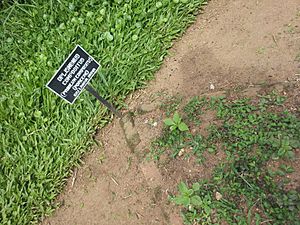Running mountaingrass facts for kids
Quick facts for kids Running mountaingrass |
|
|---|---|
 |
|
| Scientific classification | |
| Genus: |
Oplismenus
|
| Species: |
compositus
|
| Synonyms | |
|
|
Oplismenus compositus, also known as the running mountaingrass, is a type of perennial plant. This means it lives for more than two years. It belongs to the Poaceae family, which is the grass family. You can find this grass growing in many parts of the world. It grows across Asia, Africa, Australia, South America, Mexico, and Hawaii.
What Does Running Mountaingrass Look Like?
This plant can grow to be about 15 centimetres (5.9 in) to 150 centimetres (59 in) tall. That's like a small ruler to a person's height!
Leaves
The leaves of the running mountaingrass are shaped like a spearhead. This shape is called lanceolate. They can also be oval-shaped, which is called ovate. The leaves are usually 2 centimetres (0.79 in) to 16 centimetres (6.3 in) long. They are also 8 millimetres (0.31 in) to 35 millimetres (1.4 in) wide.
The veins on the leaves are arranged in a special way. You might not easily see the small cross veins. The tip of each leaf is pointed.
Flowers and Seeds
The plant has a special flower cluster called a raceme. This cluster is made up of many smaller flower parts. These parts are called inflorescence. The raceme grows on one side of the plant's main stem. It can be 2.5 centimetres (0.98 in) to 11 centimetres (4.3 in) long.
The main stem of the flower cluster is 5 centimetres (2.0 in) to 25 centimetres (9.8 in) long. It has a ridged central part called a rhachis. This part can be smooth or slightly hairy at the bottom.
Small seed-carrying parts, called spikelets, grow in two rows. Some spikelets have short stalks, and some do not. Each spikelet is about 2.5 millimetres (0.098 in) to 4 millimetres (0.16 in) long. They are also spearhead-shaped.
Inside the Spikelet
Each spikelet has two protective covers called glumes. These glumes are shorter than the spikelet itself. They are also thinner than the fertile part of the flower, called the lemma.
- The lower glume is oval-shaped. It has a stiff bristle, called an awn, which is 3 millimetres (0.12 in) to 10 millimetres (0.39 in) long.
- The upper glume is also oval-shaped. It is green and can be smooth or slightly fuzzy. It has a blunt tip and is 0 millimetres (0 in) to 4 millimetres (0.16 in) long.
The tiny flowers inside, called florets, are 2 millimetres (0.079 in) to 2.5 millimetres (0.098 in) long. They are fuzzy and have a small notch at the tip. They also have a tiny point.
Both the florets and glumes have a central ridge, like a keel on a boat. The glumes have 5 veins, while the florets have 7 to 11 veins. The seed, or fruit, is very small, only about 0.5 millimetres (0.020 in) long.

